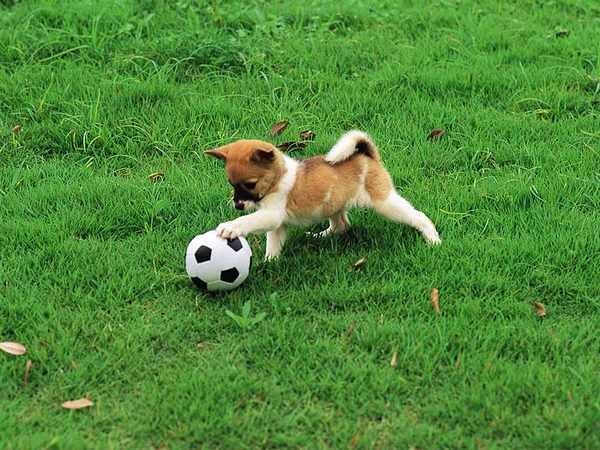The most common signs that the dog is happy are wagging tail, smile, relaxed eyes, full excitement, playful nature, and sound sleep.
If it were the desire of pet owners, they would wish their dogs could speak to them. Dogs are amazing pets that make life enjoyable for their owners.
Though dogs don’t talk, they can be happy, sad, anxious, or depressed. They have deep emotions just like us. Therefore how can you know what you do is going through? The best way to tell if your dog is happy is by observing their body language and behavior.
Dogs possess unique behaviors and body language that can tell us much about them.
Signs that your dog is happy
1) Tail Wagging
One of the most noticeable ways for dogs to express their happiness is by wagging their tail. Though not all instances when the dog is wagging their tail translate to happiness, you can tell as a pet owner when your dog is happy.
When a dog is happy, they wag their tail in a rapid motion, and this activity involves the entire body. If the dog is relaxed, they will sway the tail from side to side.
On the other hand, if the dog is wagging its tail in a stiff position, it’s an indication they are assessing a situation.
2) Appetite
Another significant indicator of a happy dog is its appetite. A happy dog has a good appetite; they will quickly finish all the food you serve them.
On the contrary, if your dog is stressed or depressed, they lack appetite. They’ll hardly be interested in eating. It’s an indication that something is wrong in their body; they may be suffering from psychological or physical problems.
When your dog isn’t interested in foods, you must take quick action to know what is wrong.
3) Expressive ears
Dogs can also use their ears to express their emotions. When a dog is happy, they’ll flop their ears into their normal position. Expressive ears are an excellent way to gauge if your dog is happy or not.
When a dog is alert or attentive, it’ll prick their ears in the forward direction. Relaxed dogs may lower or drop their ears; this happens when the dog is nervous.
At this juncture, you must be keen on other body languages to make a correct judgment.
4) Smiling
As a pet parent, you must be able to distinguish between instances when the dog is smiling or aggressive. When the dog is smiling, they relax their mouth and open it slightly. The edges appear to be curled upwards.
You should differentiate a stressed dog when they are panting due to heat stress and a happy dog.
The best way to know the difference is by reading the rest of its body language.
5) Non-destructive behavior
If your dog is happy and relaxed, they’ll hardly destroy things in the house, including their toys. If the dog is bored, they turn to anything within their reach and start crushing.
Physical and mental discomfort makes them turn to destructive behavior. If you see your dog chewing its toys or pillows cases, take the appropriate action to make her happy.
6) Relaxed eyes
A happy dog has round eyes; they maintain their eyes in ordinary shape and size. If the dog isn’t happy, they will widen or squint their eyes.
Always check the shape of your dog’s eyes to determine their psychological state. In humans, eyes are the gats to the soul; the same applies to dogs. A happy dog will gaze at you softly, and they’ll be blinking their eyes.
Additionally, their brows remain smooth.

7) Physical affection
If your dog wants to lean against you, it’s a sign they are happy and content. In this case, they seem to enjoy your company.
They express their emotions by being affectionate. This does not only mean the dog is happy but that they love you as their owner.
8) A relaxed mouth
By observing your dog’s mouth, you can know when they are happy. The shape of their jawline and mouth is indicative of the state of their emotions.
If you note relaxed patterns in these regions, then your dog is happy.
If their mouth is widely opened and they’re panting heavily, know that your dog is suffering due to heat stress.
9) Showing excitement
When you arrive home from work or a trip, note your dog’s response. If they run to you to receive you and they’re jumping onto your laps, it’s a sure sign they’re happy.
A happy dog will be excited when its dinner time, you’re going for a walk, when you treat them or any time you seek their company for a particular task.
If your dog isn’t excited to play or accompany you, then you have a reason to worry.
10) Sleeps well
Dogs love adequate sleep. A healthy dog will sleep for close to 16 hours each day. If they are still young, they may sleep for about 20 hours.
Sufficient sleep is essential for dogs; these are seasons for recharging their energy. As a dog owner, you know how long your dog sleeps, if they sleep too much, it indicates they are depressed or bored.
Additionally, a happy dog prefers to sleep in its favorite spot. When you note your dog is no longer interested in resting in its ordinary place, investigating to know what is wrong.
11) Showing curiosity
Dogs are curious creatures by nature. They always want to know what is happening around them. You’ll see them sniffing around and examine new spots and things.
Any time you discover your dog isn’t interested in sniffing around, something must be wrong. Similarly, a happy dog is excited to see new individuals; you’ll see them sniffing them trying to establish who they are.
They may even bark at a new person, especially if they figure out the person isn’t right.
12) Playful
A happy dog will enjoy playing with their owner. They are interested in any activity that will assist them in releasing their energy.
Though some dogs are more energetic, all dogs look for ways to release their energy. Fetch is an excellent way to keep your dogs and puppies active. To know about Fetch, check the article written by me on Fetch dog training.
As long as your dog is happy, they’ll be interested in playing with you or going for walks. If the dog shows any signs of fatigue, it’s indicative of physical or mental exhaustion.

13) A relaxed body
You can read your dog’s emotional stress by its overall body language. If your dog is happy, their entire body will seem relaxed. They’ll be bouncing and playing around.
14) A bark of joy
When your dog is relaxed and excited, they produce a unique high-pitched bark. This occurs when they are playing; it’s different from the sounds they produce when they are aggressive.
One way of distinguishing happy barks form aggression is that happy barks are brief.
15) Friendly behavior
A happy dog is in good moods. They will show affection to new dogs or pets. If you visit a dog’s park, you’ll discover they’re not aggressive when they see other dogs or pets.
They will also be friendly to new people. They’ll want to spend time with other dogs and pets.
16) Wanting attention
Dogs are social creatures when they are happy they’ll want to be close to you and your family members. They seek attention from humans and their fellow pets. This is a clear indication they are happy.
17) Hair conditioning
The dog’s fur also indicates their emotional state. When they are tense, scared, or nervous, their hair will stand firmly. On the other hand, a happy dog will portray relaxed and healthy fur. Each breed is different, if you have a retriever dog, then you can read an article on how should you bath retrievers.
Additionally, the fur will be in adequate amounts. Though the amount of fur in a dog’s body depends on the breed, each dog sheds its hair periodically. It essential to understand a stressed dog will shed its fur excessively.
If your dog is in this state, you should visit your vet to know what the problem is.
18) Active
A happy dog is very active. Though dogs sleep a considerable time of the day, the time they aren’t sleeping, they are engaged and moving from one place to another. If your dog isn’t happy, they will seem inactive. They will prefer staying in one place for hours or oversleeping.
What are the signs of a sad dog?
Just like humans, dogs can be depressed and sad. Their body language will show it all. They will show a different personality from what you are used to.
Unhappiness in dogs results due to several factors. They may be unhappy due to the death of a family member or another pet, or they may be stressed due to physical or psychological concerns.
The cues below are clear signs that your dog isn’t happy.
1) Licking paws
Although licking paws is normal to dogs, if excessive; you must investigate to know the cause. Excessive licking of paws in dogs is a coping mechanism just as people bite their nails or twiddle their thumbs.
By licking its paws, the dog is trying to get comfortable and soothe itself. This behavior is a way to cope with their feelings rather than the cause of the discomfort.
This behavior might be coupled to skipping meals and can result in severe weight loss if not countered.
2) Lethargy
When a dog is sad, they will lack interest even in activities they crave for like going for walks and playing. They’ll spend most of the time sleeping.
If you note your dog is oversleeping, it’s a sure signal they are stressed or ill — they are not happy.
If you get home and your dog is nowhere to welcome you, then you should investigate what is going on with your favorite friend.
3) Hiding
When a dog is healthy and happy, they prefer spending their time with the family. The converse is also true; when they are unhappy, they will avoid coming into contact with family members.
They will prefer to be in seclusion. Hiding can be a sign of emotional stress in dogs. An unhappy dog will hide under the bed, or in the closets. You may discover them lonely in a corner.
If you note this behavior in your dog, you should take immediate action, since it could mean there’s a hidden underlying health issue.
4) Weight loss
Though with loss may not be an immediate sign of an unhappy dog, it means your dog isn’t healthy. When your dog is sad, they’ll lose appetite, thus lose weight if this state prolongs.
The dog will start by skipping meals, if they were taking four meals in a day, they’ll turn to two meals per day. If you discover your dog is no longer interested in food, you must take immediate action.
VCA animal hospitals website explains various other reasons too which cause weight loss in dogs.
On the same note, some dogs may result in overeating to deal with their sadness. This behavior can have a drastic effect on their health, just like skipping meals. They need to visit the vet soonest.
5) Lack of appetite
Dogs, just like other animals, love food. They are always salivating when they sense meal time is around the corner. When you realize your dog is no longer interested in meals, it’s a worrying sign.
Lack of appetite in dogs does not only mean your dog is sad but also that there is a serious health condition that needs to be addressed with immediate action.
6) Lack of interest in their toys
When your dog is in the right moods, they’ll be begging you to play. You’ll see playing with their toys frequently.
If this behavior changes, your dog may be depressed. A healthy and happy dog wants to exercise, play with humans, their toys, and other pets.
If your dog has lost interest in the toys, it’s not that they are bored; it’s a sign of unhappiness.
7) Oversleeping
Ordinary dogs sleep for around 10 hours each day. The trend is different when your dog is sad; they may sleep for 15 hours if they are mature dogs.
If it’s a puppy, no worry if they sleep for 20 hours, but a healthy mature dog shouldn’t. Such behavior warrants a visit to the vet.

How can you make your dog happy?
If you’re able to identify the cause of sadness in your dog, you can help restore her to her perfect condition. A healthy dog is a happy dog. You can easily rejuvenate your dogs through the following ways.
1) Dancing
If you don’t know, dog love dancing! That’s why the Canine Freestyle Federation is so popular. It’s an excellent opportunity to perfect the bond between the pet and its owner.
Therefore every time you want to bond with your dog, always include a few favorite tunes and engage your dog into a dance.
Your dog will also love it if you sing them a song.
2) Treasure hunts
A treasure hunt is an exciting way to make your dog happy. Hide treats in several locations in your home and let your dog engage her skills to locate them.
In this adventure, they will be active; thus, the activity will wipe away any boredom or depression. After a week, you can repeat the exercise by placing the treats in different locations.
This game will encourage your dog to be explorative.
3) Purchase new toys for your dog
Just like children, dogs can be bored playing with the same toys for a long time. It’s time to purchase new toys for your pet.
If you have many toys for the pet, you can try alternating them; hide some for a while and bring them back, the dog will view them as new toys.
Your dog will love surprises in the form of treats. Additionally, vary the toys; buy toys of different colors, sizes, and shapes.
4) Assign them some duties
Mature, healthy dogs prefer been active. They want a way to utilize their high energy levels. Just like adult humans, older dogs will be bored if they have nothing to do.
If you’re going for a walk or a hike, let your dog assist in carrying some treats. They can even handle simple tasks like picking your keys. These simple tasks will keep them mentally stimulated.
5) Allow them to play with a sprinkler system in the hot sun
In summer and other hot months, your dog desires to have a way of cooling their bodies.
During these months, you’ll discover your dog panting heavily due to heat stress. You can bring in some life to them by allowing them to play under a sprinkler system.
Before you let them into the game, make sure the system is running.
6) A walk
Going for walks with your dog isn’t only great for exercise but also for stimulating your dog mentally. Just like us, a dog wants some time out. Imagine staying in one place for months?
How would life be like? The same applies to dogs; create in your busy schedule to go for walks with your pet; at least once per week.
Alternatively, you can organize hikes and retreats for the same purpose. These activities are excellent ways of spending quality time with your dog.
7) Talking to your dog
Though dogs do not speak, they understand our language. Talking to your dog is one way of making them happy. But as you speak to them, you must mind the tone of your voice.
Don’t shout or yell at your dog, when talking to them; they will regard you as unfriendly. Use a soft and friendly tone when conversing with your dog.
You’ll be amazed at how this trick can offer to your pet.
8) Visit the Vet
If your dog is unhappy, it could be due to a health issue. Visiting the vet is one of the best ways to make your dog happy. The vet will examine them and offer the best solution to their problem.
Avoid becoming the vet; you don’t have adequate knowledge to treat your dog. Any time you have any worries about your dog, visit your vet.
9) Sleeping on your bed
If it doesn’t disturb you to have your dog in your bed, permit them to sleep in your bed. When your dog is sad or depressed, they need a company to make them feel better.
Permitting your dog to sleep on your bed is a sure way of showing affection. They’ll be pleased to sleep close to their master.
10) Turn on YouTube
Just as much as you like watching stuff on YouTube, your dog will also be excited to watch Yu Tube.
You can allow your dog to watch videos of other dogs, cats, or even wild animals on YouTube. Choose a playlist of exciting fun videos and let your dog sit comfortably on a seat.
This exercise will work a miracle to stimulate your dog mentally.
11) Train them on new tricks
Dogs love learning new tricks. Teaching your pet new skill is an ideal way of spending quality time with the pet. Additionally, it’s an opportunity to stimulate your dog mentally.
No matter your dog’s age, they can learn new tricks. Include treats in this exercise to make it more exciting.
12) Bathing
Though your dog doesn’t require a bath every week, frequent showers will make the feel clean and fresh. By bathing your dog, you help them remain clean and get rid of any allergens on their fur.
Besides, you’re getting rid of any parasites like fleas from their bodies. Consider regular baths as a way of refreshing your dog and making them happy.

13) Play hide and seek
Another excellent way to stimulate your dog mentally and make them happy is playing hide and seek. But make sure you have trained them on how to wait as you hide before they start locating where you’ve hidden. This is an excellent simple game to play in the afternoons.
14) Compliments
Every time your dog does a good thing, you need to compliment them. This act will make them motivated to be good companions. Just as human love compliments, it works magic for dogs too.
Compliments and positivity are sure ways of perfecting the bond between your and the dog. Your dog will become more loyal and friendly.
The converse will happen if you keep on yelling at them every time they make a mistake.
15) Leave your window opened
When you go for work, shopping or other activities and you’ve left your dog at home, consider opening the window.
Your dog will use this opportunity to keep them busy as the look, smell, and hearing what is happening around them.
It’s an ideal way to keep your dog stimulated. Besides, they’ll have access to fresh air and sunlight.
Conclusion
Dogs are emotional creatures; they feel appreciated when you do things that make them happy. When you note any other the signs that signify your dog is unhappy, look for a way to stimulate them.
This article has offered excellent tips to identify when your dog is happy, unhappy, and methods of making them happy. Implement these tips and keep your dog stimulated.
References
Table of Contents
